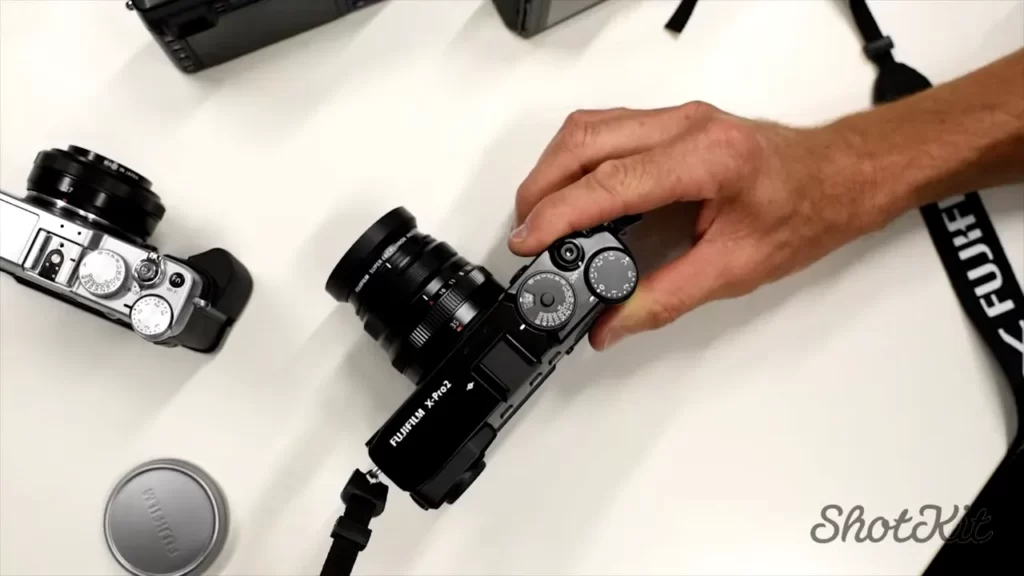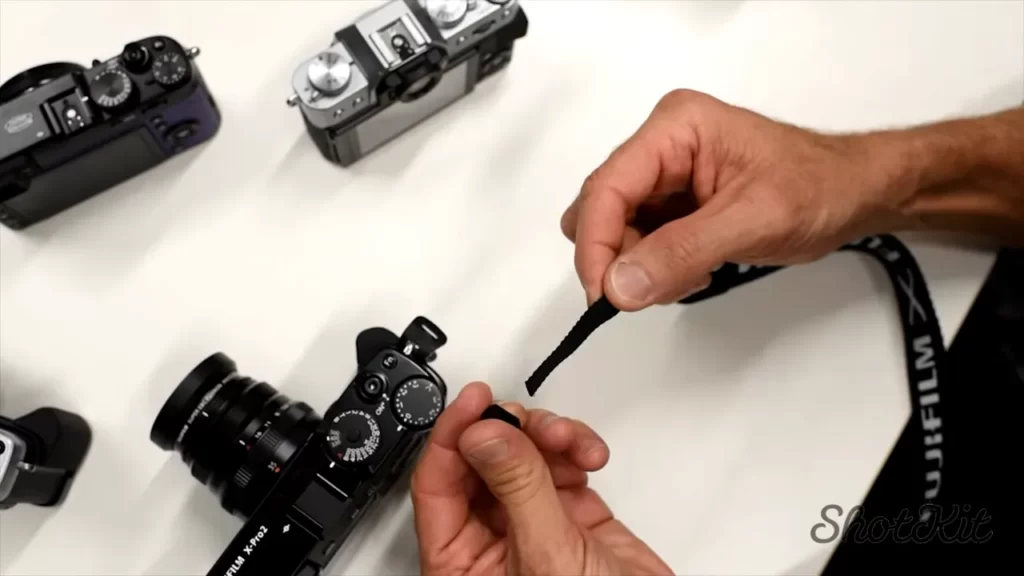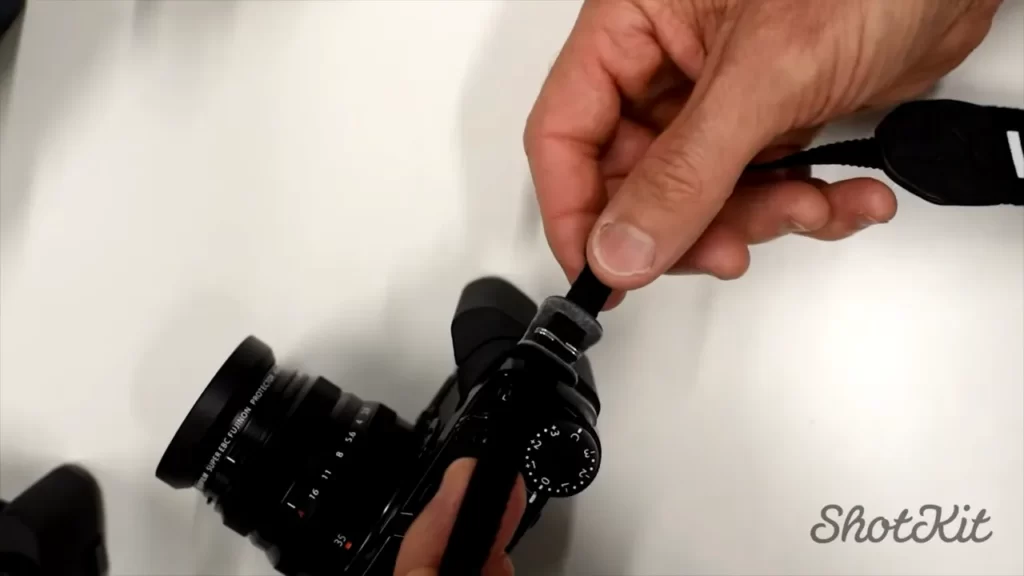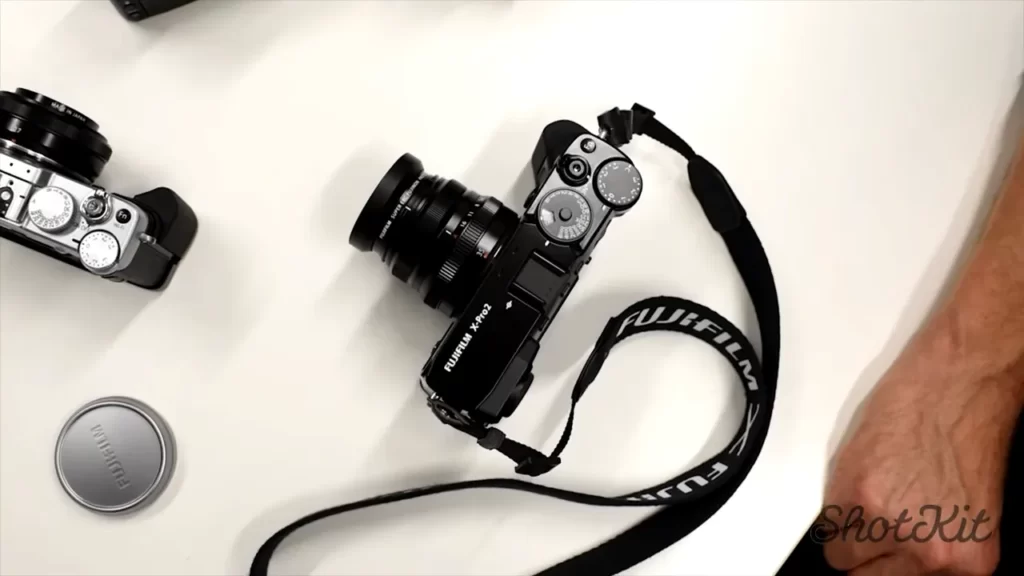To install a camera strap, attach one end to the strap lug on the camera body, and then thread the other end through the strap loop or buckle. Having a camera strap is essential for photographers as it provides a secure and comfortable way to carry their camera while on the go.
Whether you are a professional photographer or an enthusiast, a well-installed camera strap ensures that your precious camera is safely attached to you, preventing accidental drops and damages. With a few simple steps, you can easily install a camera strap and enjoy the convenience and peace of mind it offers.
We will guide you on how to properly install a camera strap to maximize its functionality. Let’s get started!
Why A Well-Installed Camera Strap Is Essential For Photography

A camera strap might seem like a small accessory, but it plays a crucial role in ensuring a smooth and productive photography experience. A well-installed camera strap not only provides comfort and convenience, but it also reduces the risk of accidents and enables quick and easy access to the camera. In this article, we will explore these benefits in detail and guide you on how to install your camera strap properly.
Comfort and Convenience
One of the most important reasons to have a well-installed camera strap is the comfort it provides. When you are out in the field capturing stunning shots, you might be carrying your camera around for hours. Without a comfortable camera strap, your neck and shoulders can start to ache, which not only hampers your photography but can also lead to long-term discomfort.
A well-installed camera strap evenly distributes the weight of your camera, relieving stress on your neck and shoulders. This allows you to concentrate on composing the perfect shot without any distractions or pain. Additionally, a comfortable camera strap can help you maintain stability while shooting, resulting in sharper images.
Reduces the Risk of Accidents
The last thing any photographer wants is for their expensive camera equipment to be damaged due to an unfortunate accident. With a well-installed camera strap, the risk of dropping your camera significantly decreases. By securely attaching your camera to your body, you can have peace of mind knowing that it won’t slip out of your hands and end up hitting the ground.
Whether you are shooting in crowded areas, rugged terrains, or from various angles, a reliable camera strap will keep your precious gear safe. It acts as a safety net, preventing accidental drops and minimizing the chances of physical damage to your camera. By investing a little time in properly installing your camera strap, you can protect your valuable equipment and save yourself from expensive repairs.
Enables Quick and Easy Access to the Camera
Another crucial benefit of a well-installed camera strap is the quick and easy access it provides. When an unexpected photo opportunity arises, you don’t want to waste time rummaging through your bag or fumbling with your camera. A securely attached camera strap allows you to grab your camera in an instant, ensuring you don’t miss any memorable moments.
With a well-installed camera strap, you can keep your camera within arm’s reach, hanging comfortably on your side. This allows for seamless transitions between shooting and other activities, such as hiking or socializing. Moreover, a camera strap with adjustable length gives you the flexibility to shoot at various angles without needing to detach or reattach the strap constantly.
In conclusion, a well-installed camera strap is an essential accessory for every photographer. It provides comfort and convenience, reduces the risk of accidents, and enables quick and easy access to your camera. By taking the time to install your camera strap properly, you can enhance your photography experience and protect your valuable equipment. So don’t overlook this crucial aspect and ensure your camera strap is securely attached before your next photo adventure.
Choosing The Right Camera Strap For Your Needs
When it comes to photography, having the right equipment is crucial to getting the best shots. While most photographers focus on their cameras and lenses, one often overlooked accessory is the camera strap. A good camera strap not only helps to secure your camera but also adds comfort and convenience while shooting.
Consider the type of photography you do
Before you start looking for a camera strap, it’s important to consider the type of photography you do. Different photography styles require different types of camera straps that cater to specific needs. For example, if you are a wedding photographer who needs quick and easy access to your camera, a sling strap would be a great choice. On the other hand, if you often shoot wildlife photography, a sturdy and adjustable neck strap would be more suitable.
Factors to consider when choosing a camera strap

When choosing a camera strap, there are several factors to keep in mind to ensure it meets your needs perfectly. These factors include:
- Comfort: Look for a camera strap that provides adequate padding or cushioning to prevent discomfort during long photoshoots. Adjustable straps can also help achieve the perfect fit.
- Durability: Your camera strap should be able to withstand the weight of your camera and any additional accessories you may use. Look for straps made of high-quality materials such as nylon or leather, which offer better durability.
- Security: It’s important to choose a camera strap that securely fastens your camera and reduces the risk of accidental drops. Look for straps with reliable fastening mechanisms, such as quick-release buckles or strong attachment points.
- Style: While not a functional requirement, the appearance of your camera strap can be a personal preference. Choose a strap that complements your style and personality.
Reviewing different types of camera straps
There are various types of camera straps available in the market, each designed to suit different shooting styles and preferences. Here are a few common camera strap options:
| Type of Camera Strap | Description |
|---|---|
| Sling Strap | A sling strap is worn across the body, allowing quick access to your camera while keeping it secure. It’s great for photographers who need to move quickly and shoot on the go. |
| Neck Strap | A neck strap is worn around the neck and is a common choice for most photographers. It provides stability and convenience, especially for photographers who shoot with lightweight cameras. |
| Wrist Strap | A wrist strap is a compact option that attaches directly to your camera’s body, keeping it secure in your hand. It’s ideal for photographers who prefer a minimalist setup or shoot with smaller cameras. |
| Harness Strap | A harness strap distributes the weight of your camera across your shoulders and upper body, reducing strain during long shoots. It’s popular among photographers who carry heavy equipment or shoot in challenging conditions. |
By considering your photography style and the factors mentioned above, you can choose the camera strap that best suits your needs. Remember, a well-chosen camera strap can make a significant difference in the comfort and convenience of your photography experience.
Preparing Your Camera For Strap Installation
Before you can start enjoying the convenience and security of a camera strap, there are a few key steps you need to follow to prepare your camera. By taking the time to gather the necessary tools, inspect your camera for strap attachment points, and ensure your camera is properly cleaned and free from debris, you can make the installation process smooth and seamless. Let’s dive into each step in more detail:
Gather the necessary tools
First things first, make sure you have all the tools you need to install your camera strap. Having the right tools on hand will save you time and frustration. Here’s a list of items you’ll need:
- Screwdriver (check the type and size that your camera requires)
- Camera strap with attachment hardware
- Lint-free cloth
Inspect your camera for strap attachment points

Next, take a close look at your camera to find the attachment points for the strap. They are usually located on the sides or bottom of the camera body. These attachment points may be in the form of small metal loops or slots. Inspect them carefully to ensure they are in good condition and securely attached to the camera body.
If you’re having trouble finding the attachment points, refer to your camera’s user manual or do a quick search online for your specific camera model. Remember, each camera may have slightly different attachment mechanisms.
Ensuring your camera is properly cleaned and free from debris
Now that you’ve located the attachment points, it’s time to clean your camera to ensure a secure and long-lasting strap installation. Use a lint-free cloth to gently wipe down your camera body, paying close attention to the areas around the attachment points. Make sure to remove any dust, dirt, or debris that may interfere with the strap attachment or damage your camera.
For stubborn dirt or grime, you can moisten the cloth slightly with water or use a gentle camera cleaning solution, following the manufacturer’s instructions.
Once you’ve cleaned your camera thoroughly, double-check that the attachment points are dry before proceeding to the next step.
Now that you have gathered the necessary tools, inspected your camera for strap attachment points, and ensured your camera is properly cleaned, you are ready to move on to the exciting part – installing your camera strap!
Attaching The Camera Strap To Your Camera
When it comes to using a camera strap, properly attaching it to your camera is crucial for the safety and security of your equipment. Whether you’re a professional photographer or an amateur enthusiast, having a reliable camera strap can make a significant difference in your photography experience. In this article, we will guide you through the process of attaching your camera strap to your camera, step by step.
Locating the strap attachment points on your camera
Before you can attach the camera strap, you need to locate the strap attachment points on your camera. Typically, most cameras have two attachment points – one on each side of the camera body. These attachment points are usually metal loops or small brackets, specifically designed for the purpose of attaching a camera strap. Take a moment to familiarize yourself with these attachment points on your camera.
Connecting the camera strap securely
Once you have identified the attachment points on your camera, it’s time to connect the camera strap securely. Ensure that the camera strap is untangled and properly positioned before proceeding with the attachment process. Begin by threading one end of the camera strap through the attachment point on the right side of your camera, making sure it is securely threaded through the loop or bracket. Repeat the same process for the attachment point on the left side of your camera, ensuring the camera strap is taut and not twisted.
Adjusting the strap length for optimal fit
Once the camera strap is securely connected to your camera, the next step is to adjust the strap length for optimal fit. The strap should be adjusted to a length that ensures a comfortable and secure hold of the camera while keeping it within easy reach. To adjust the strap length, simply slide the adjustable buckle along the strap until you achieve the desired length. It’s important to note that the optimal length may vary for each individual, so take the time to find a length that feels comfortable and suits your shooting style.
By following these simple steps, you can easily attach your camera strap to your camera, ensuring both safety and convenience during your photography sessions. Remember, having a properly attached camera strap provides peace of mind, allowing you to focus on capturing those unforgettable moments.
Ensuring Proper Weight Distribution And Strap Adjustment
When it comes to installing a camera strap, ensuring proper weight distribution and strap adjustment is crucial for your comfort and stability while shooting. By balancing the weight of your camera, customizing the strap length and positioning, and testing the comfort and stability of the strap, you can optimize your shooting experience and prevent unnecessary strain on your body.
Balancing the weight of your camera
One of the key factors in ensuring proper weight distribution is balancing the weight of your camera. A heavy camera can put excessive strain on your neck and shoulders, leading to discomfort and fatigue. Balancing the weight involves securing the camera strap in a way that prevents it from pulling in one direction.
Here’s a simple step-by-step guide for balancing the weight of your camera using the camera strap:
- Attach the camera strap to your camera securely.
- Hold the camera by the strap and check if it hangs level and centered.
- If the camera tilts or leans to one side, adjust the strap length on that side to balance it out.
- Repeat the process until the camera hangs evenly and feels comfortable to hold.
Customizing the strap length and positioning

Customizing the strap length and positioning is important for achieving optimal comfort and ease of use. Everyone’s body is different, so it’s essential to adjust the camera strap to suit your preferences and shooting style. Here are a few tips to help you customize the strap length and positioning:
- Start by adjusting the length of the strap to a comfortable and secure position around your neck or shoulder.
- Experiment with wearing the strap diagonally across your body for added stability.
- Consider using a padded strap for extra cushioning and support.
- Ensure that the strap allows you to reach the camera controls easily without straining your arm or shoulder.
- Check that the strap doesn’t obstruct your viewfinder or interfere with your lens.
Testing the comfort and stability of the strap
Once you have followed the above steps to balance the weight and customize the strap length and positioning, it’s important to test the comfort and stability of the strap before heading out for a shoot. Here are a few things to keep in mind while testing:
- Put the camera strap on, and adjust it to your desired length and position.
- Walk around with the camera attached to the strap and observe how it feels on your neck, shoulder, and back.
- Check if the strap stays in place while you move, ensuring that the camera remains secure at all times.
- Pay attention to any pressure points or discomfort, and make necessary adjustments to the strap.
By taking the time to balance the weight of your camera, customize the strap length and positioning, and test the comfort and stability, you can ensure a comfortable and enjoyable shooting experience. Remember, a properly adjusted camera strap not only protects your equipment but also enhances your ability to capture those perfect shots effortlessly.
Using Accessories To Enhance Camera Strap Functionality
Using accessories to enhance camera strap functionality can greatly improve your photography experience. These add-ons not only provide additional comfort but also offer convenience and security. In this section, we will explore three essential accessories that can take your camera strap to the next level.
Utilizing Strap Pads for Added Comfort
If you find that your camera strap digs into your shoulder or causes discomfort during long shoots, strap pads can be a game-changer. These pads are specifically designed to cushion the weight of your camera, relieving pressure and reducing strain on your neck and shoulder muscles.
Strap pads are usually made of soft, durable materials such as neoprene or foam. They are easy to install and can fit most standard camera straps. To attach a strap pad, simply slide it onto your camera strap and position it on the area where it rests on your shoulder. The pad will provide an extra layer of cushioning, allowing you to shoot for longer periods without any discomfort.
Exploring Quick-Release Systems for Convenience
Imagine being able to detach your camera from the strap with just a simple click. With a quick-release system, this becomes a reality. Quick-release systems are designed to provide instant access to your camera while keeping it securely attached to your strap.
These systems consist of two components: a baseplate that attaches to the bottom of your camera and a mounting plate that connects to your camera strap. The two plates are equipped with a quick-release mechanism that allows you to easily attach and detach your camera. This feature is particularly handy when switching between handheld and tripod-mounted shooting.
To install a quick-release system, attach the baseplate to the tripod mount on the bottom of your camera. Then, connect the mounting plate to your camera strap using the designated attachment points. Once both plates are securely in place, you can effortlessly attach and detach your camera whenever needed.
Attaching Secondary Straps for Added Security

For added peace of mind, consider attaching secondary straps to your camera. These straps serve as backups, preventing your camera from accidentally falling if the primary strap fails.
Secondary straps can be attached to various parts of your camera, such as the sides or the straps themselves. They are usually made of durable materials like nylon or polyester and come with easy-to-use buckles for quick attachment and detachment.
To attach a secondary strap, simply loop it through the designated attachment points on your camera and secure it with the buckle. Make sure the strap is tight enough to keep your camera secure but still allows you to move freely while shooting.
By utilizing strap pads, quick-release systems, and secondary straps, you can enhance both the comfort and security of your camera strap. These accessories are easy to install and can make a world of difference in your photography journey. Take your camera strap to the next level and enjoy a more comfortable and convenient shooting experience.
Developing Proper Camera Strap Habits For Optimal Photography
Installing a camera strap is essential for every photographer, ensuring the safety and security of their expensive gear. However, simply putting on a camera strap is not enough to optimize your photography experience. Developing proper camera strap habits is crucial to achieve optimal results. In this blog post, we will explore effective techniques to maintain good posture and body mechanics, utilize the camera strap as a stabilizing tool, and unlock creative shooting techniques using the strap.
Maintaining good posture and body mechanics
When it comes to photography, proper posture is not only important for your overall well-being but also for capturing stunning, shake-free images. Maintaining good posture while carrying your camera using a strap is a simple yet powerful habit to develop. Here are a few tips to consider:
- Keep your shoulders relaxed.
- Ensure your back is straight, distributing the weight of the camera evenly.
- Avoid slouching or hunching forward, as it can strain your neck and back.
- Position the camera strap diagonally across your chest or around your neck for better weight distribution.
Using the camera strap as a stabilizing tool
Your camera strap can do more than just prevent accidental drops. It can also act as a valuable stabilizing tool, allowing you to capture sharp images even in challenging conditions. Here’s how to utilize your camera strap for stability:
- Wrap the camera strap around your wrist or hand, creating tension to steady your shots.
- Loop the camera strap around a stable object, such as your arm or a nearby pole, to create additional support.
- Hold the strap tightly while shooting, using it to minimize camera movement and vibrations.
Utilizing the strap for creative shooting techniques
In addition to maintaining good posture and using the strap for stability, you can also explore unique shooting techniques that the camera strap enables. Try out these creative ideas to add a distinct touch to your photography:
- Experiment with “strap panning” by holding onto the camera strap and smoothly moving it in sync with your subject’s motion, creating a dynamic effect.
- Attach the camera strap to objects around you, such as trees or poles, to achieve interesting aerial perspectives or unique angles.
- Use the camera strap as a makeshift tripod by attaching it to a solid surface, allowing you to capture steady, long-exposure shots.
By integrating these habits into your photography routine, you can enhance the quality of your images and enjoy a more comfortable shooting experience. Remember, developing proper camera strap habits is a journey, so take the time to practice and find what works best for you.
Frequently Asked Questions For How To Install Camera Strap
How Do You Attach A Camera Strap To Your Hand?
Attach a camera strap to your hand by following these steps: 1. Locate the strap lug on your camera. 2. Thread the strap through the lug. 3. Adjust the strap length to fit your hand comfortably. 4. Secure it by tying a knot or using the provided attachment mechanism.
5. Ensure the strap is securely attached before use.
How Do You Wear A Camera Strap?
To wear a camera strap, simply slide it over your neck or shoulder and adjust it for comfort. Make sure the strap is securely attached to the camera using the provided connectors or loops. Ensure that the camera is balanced and easily accessible for quick shooting.
You’re ready to capture those memorable moments!
How Do You Attach A Rope Camera Strap?
To attach a rope camera strap, follow these steps: 1. Locate the strap attachment points on the camera body. 2. Thread one end of the rope strap through the attachment point, ensuring it is secure. 3. Repeat the process for the other end of the strap.
4. Adjust the length as desired and test the strap’s strength before use.
How Do You Attach A Camera To A Bag Strap?
To attach a camera to a bag strap, use a camera strap or sling strap with a quick-release buckle. Connect one end to the camera’s strap loops and the other end to the bag strap. Ensure it’s securely tightened before using.
How Do I Install A Camera Strap?
To install a camera strap, first, locate the strap attachment points on your camera. Then, thread the strap through the attachment points and secure them tightly.
Conclusion
Installing a camera strap is a simple process that ensures comfort and security while using your camera. By following these easy steps, you can attach your camera strap securely and confidently. Remember to choose a strap that matches your needs and style.
Whether you are a professional photographer or a hobbyist, a properly installed camera strap will provide you with the necessary convenience and peace of mind.
